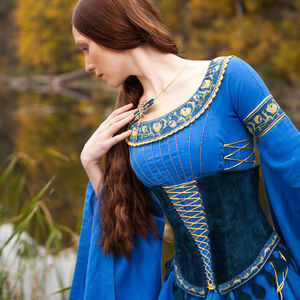Medieval and Renaissance Corsets for Sale
“A wide belt with the addition of rigid inserts, laces or buckles and hooks” — such a definition of corset was obviously given by boring people. Currently, no royal decree obliges modern women to wear corsets. So why corsets are still popular? To buy a medieval corset means to be in a special mood: light, playful and sublime. Wearing a medieval or a renaissance corset, you immediately feel quite differently: your posture becomes proud, your waist becomes slimmer, and the whole figure looks particularly elegant. There is no doubt that wearing a renaissance corset or a bodice you'll feel like a queen of a magnificent ball, approaching that same image that always accompany you in your dreams
We have a great selection of corsets for sale in our store:
- Classic medieval corset undergarments
- Medieval soft bodices
- Renaissance boned corsets
- Renaissance soft bodice underwear
- Fantasy corsets
History of Medieval Corsets
Initially, the corset was a prerogative of the men's wardrobe, often made of metal and leather it resembled armor. The ancient Greeks and Romans classicized tight body, and ancient corset slimmed the stomach and also the chest, but caused unimaginable pain. Since the 14th-century clothes commonly have been adjusted to the size by lacing. And the first medieval corset in its usual sense has been made for Joana of Portugal in 1461. Allegedly, she ordered a tailor to make such a bodice, through which she could look slimmer, and he made the corset consisting of the metal plates. Further, the corset was marked in the biography of the royals, such as Isabella I of Castile and Catherine de' Medici, thanks to whom the corset has become really popular and important part of fashionistas wardrobe.
Medieval Corsets Design and Types
Normally medieval corset covered the torso, beginning at the level of the armpits or directly under the breasts, and ending above the hips, sometimes stepping on them and, in some very rare cases, reaching the knees. Fashion historians call medieval corset as “an instrument of torture” - they had an elaborate design, which made it possible to pull the average ladies waist up to 12 inches. Ladies fainted from the inability to take a deep breath, but even pregnant women worn corsets to hide their delicate state. Also, there was a shorter form of the corset, which covered only the waist, called “waist cincher”. The waist cincher supported the breasts from below, and was an antipode of the modern bra, which carries the weight of the breasts to the shoulders, and supports it with the help of the straps. Medieval bodice as a separate piece of clothing intended to be worn over the top of the dress stood out even later, not earlier than the 16th century. Rare decent woman dared to go out without a corset or a bodice.
ArmStreet Medieval Corsets
Both corset and bodice have been modified considerably over time: the metal bones were replaced with the whalebones, satin and silk substituted the leather. Today, we use plastic bones making medieval bodice for sale, because they are more flexible, so it's much easier to get used to this novelty in your wardrobe. Secondly, plastic is lighter and reduces the weight. Given the variety of images that can be supplemented with a middle ages bodice, we make them of natural velvet, suede leather, cotton and even flax linen.
Since its appearance, the corset was not intended to be worn by a woman on her own, it had to be tightened by another. Today's waist ideals are far more democratic than 15 inches, so you do not have to tighten the laces mighty. Put on a corset and start to pull the laces from the top down to the bottom (or ask a friend to do it) and tie the ends of the laces. Remember that your movements will be constrained when wearing the corset at the very first time. Tighten of the laces gradually, 2 or 4 inches will be enough. Walk around the house a little wearing the corset, get used to it, and then you can wear it to a party.
You can buy medieval bodice to wear it under your dress to reduce the waist secretly, or give preference to a smart velvet corset, which fits great with the wedding or evening dress. We also care of those who are not yet ready to suffer in the name of beauty and tighten their waist with bones, so in our medieval bodice store one can find completely boneless but fitted models - they are as beautiful as the authentic corsets, but their design is closer to the modern vests and they are very comfortable to wear.
Renaissance Corsets
The Renaissance Corset is a pinnacle of Renaissance Costume fashion, this garment has created one of the most easily recognisable and fashioneable silhouettes of all times.
Renaissance corsets were typically made of stiffened organic fabric, such as linen or canvas, laced up to form the waist and lift the bust. They were either decorated with embroidery and trimming to be worn over the dress, or used as an undergarment to form the shape under the main dress.
Renaissance corset design
The Renaissance period was a time of great artistic and cultural achievement, and the Renaissance Corset design was a reflection of the visual and cultural traditions of this period. Renaissance corset design is one of the most recognizable pieces of the Renaissance costume, characterized by the goals: to accentuate the female figure and to emphasize the status and wealth of the noble wearer. So, the attention to detail, sophisticated construction, and expensive materials were a signature part of the look. Renaissance-period corsets and bodices were made with great attention to detail from expensive silk, velvet, and brocade and are still popular in the modern fantasy and historical fashion culture.
Medieval and Renaissance Corsets features:
- Variety of fabrics — velvet, suede, leather, linen and cotton corsets;
- Plastic boning — light and flexible;
- Boneless but fitted bodice vests;
- Can decrease the waist circumference by 6 inches;
- Fits great with LARP, period, evening and wedding dresses.











